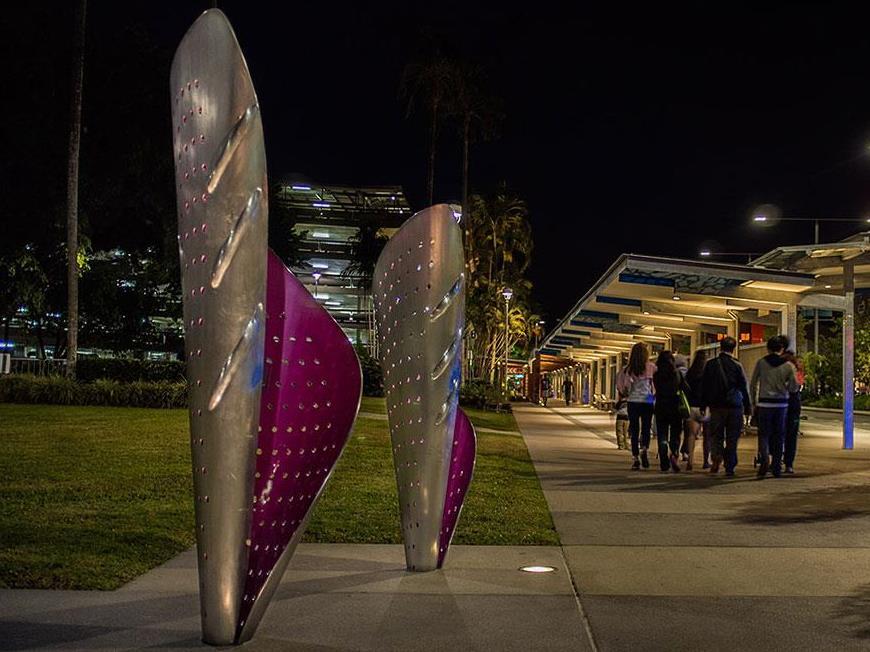Sebastian Di Mauro’s stunning public artwork, Rise, in Cairns’ Lake Street precinct; courtesy the artist and CreativeMove
Responding to a recent panel talk under the Art Month Sydney Program You can’t put that there, I take issue with the notion that if we make more public art ‘temporary’, then it will be better as a ‘practice’ and perhaps acceptable to more people – all because it is short-term and will soon go away.I am not comfortable with this for a range of reasons. Short-term, temporary or ephemeral public art has no less responsibility just because it’s not permanent. It still needs to be aesthetically rigorous; it still has to respond to issues of site, place, and community engagement; and it still needs to make us think or consider why it is there.
Nevertheless, temporary works are a very good strategy to get people excited and talking about their public places and thinking about art when they may not expect to. It also allows artists to be experimental and to gauge audience responses, while still saying something meaningful in the process.
Artists do this all the time in gallery shows, but there they also are endeavouring to make works that ‘stick’ – that have legacy, and that may be picked up by public museums and collections because they are worthy of charting our development as a society and document the development of our arts practice within our society.
I want to make a case for the courageous and diligent artists and curators who do not approach their work with decoration foremost in their minds. Those who aim to permanently position an artwork within a public place or civic building, having given considerable thought to its role in a city or town, its relevance to both its site and place, and its contribution to the existing urban landscape and that city’s private/public art collection that it fits into/sits alongside/within.
I want to make the case that these artists and curators want art that ‘sticks’ and that doesn’t fade easily in both relevance and engagement because they accept the challenges that public art offers.
I don’t believe that the ratio of good to bad public art, as some have suggested, is 5:95. Certainly, anyone working in this area will acknowledge that poor quality public art exists. This may be due to poor client briefs; insufficient budgets; unreasonable timelines given to artists to develop appropriate responses; disrespect among some of the design or construction team for the professional and collaborative role an artist plays in project conceptualisation; and, yes, sometimes, the inexperience of the artist commissioned.
Other times, the reason for bad public art is because an artist has been asked to produce a concept, often in advance of being commissioned, for a project that they are unfamiliar with. Forget about ‘Bert’s Balls’ in Rundle Mall – its ‘crystal balls’ in every artist EOI going!
At times, the message seems to be: “Dispense with quality research and any meaningful engagement and just give us your indicative visualisations and concepts and tell us how you will approach this commission… Oh, and can you submit this in two weeks (for no payment)?”
Public art can be a disrespectful and brutal commissioning courtship if process and outcomes that have legacy implications for all aren’t valued. It can lead to a troubled engagement that will only yield a marriage of convenience between art and the built environment.
Some other points to think about: How many bad buildings are out there? Many. And we have to tolerate them every day – as we commute to work, sit in the park, visit friends or simply go for a walk. Are all those builders (who often work without the advice of a capable, professional architect) being held to account for their built-environment transgressions? Sure, Councils approve DA’s all the time, but is it ‘architecture’ they’re approving?
A good proportion of the public domain is still being designed without qualified architects. Thankfully, through government policy commitment and enlightened developers, and their discerning customers who won’t pay for shoddy – or, dare I say, boring – design, we are starting to see much better quality in our public spaces and built environment.
Public art often makes people look twice and wonder why an artwork might be right there in front of them on the street. Sure, some go unnoticed, and some deserve to. But many don’t, and if they prompt responses, of all kinds, then this is a good thing. If these responses are negative, then that is entirely a citizen’s democratic right.
We know that public art will hardly ever be considered within its holistic framework of commissioning and that most viewers will be lay-people. Let’s continue to do our best as professionals to be clear about our principles, processes and motivations, and when we do deliver these artworks, let’s be honest about them and be clear with our information so that people who ask for more context can continue to make their judgment.
That judgment may change over time – and often does – towards the affirmative.
Public art is a challenging process, and should not be entered into lightly. No one should think that it is not a specialist area; it requires a multitude of skills, and we should encourage built-environment colleagues, politicians, developers, and the public at large to respect that public art is a process, a product, and a meaningful part of our built fabric.
All of this should be undertaken and delivered with our best intentions, professional abilities, and a mutual commitment to better public places for our cities.





